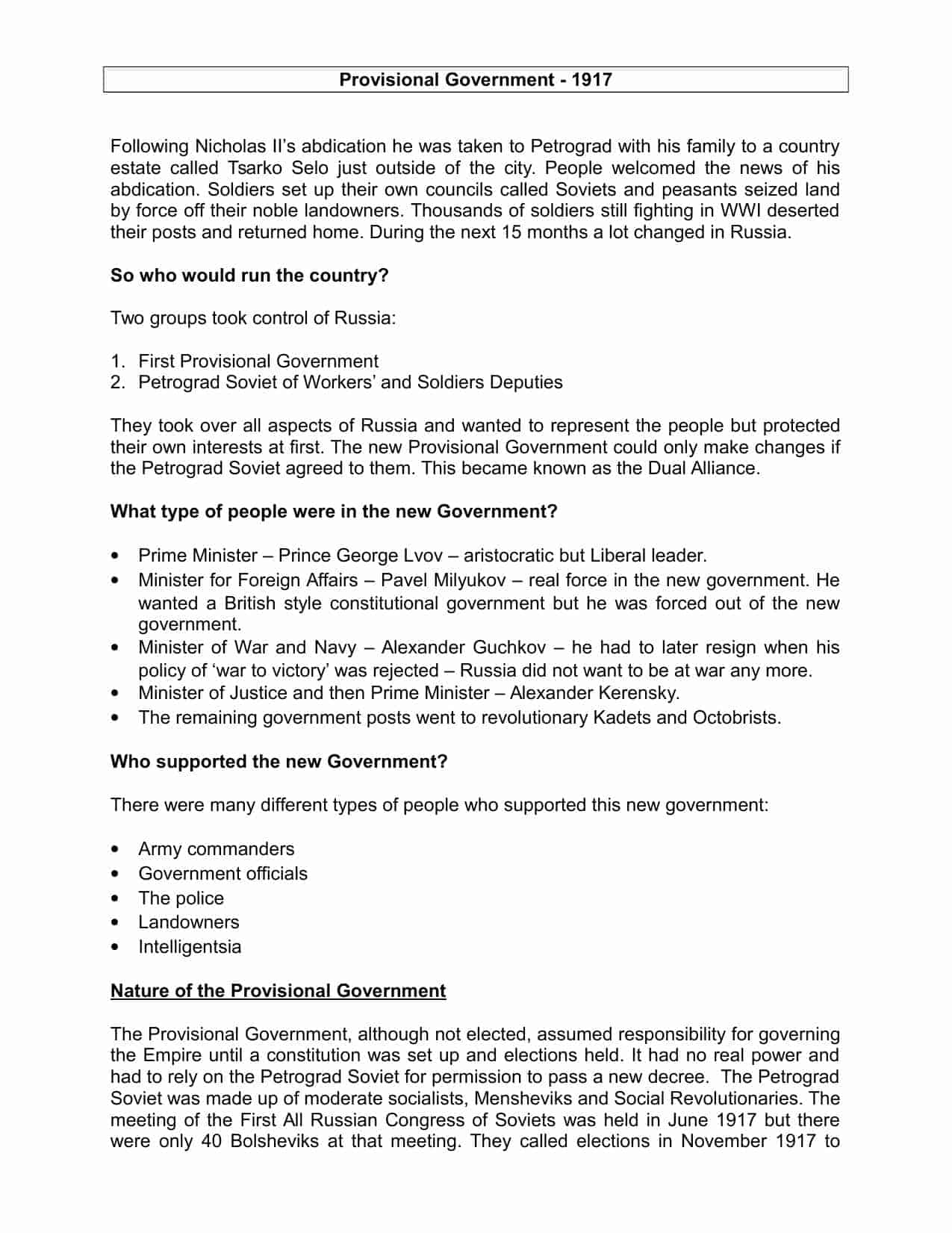Download Russian Provisional Government 1917
Click the button below to download this worksheet for use in the classroom or at home.
Download →
Team Snapshot:
Following Nicholas II’s abdication he was taken to Petrograd with his family to a country estate called Tsarko Selo just outside of the city. People welcomed the news of his abdication. Soldiers set up their own councils called Soviets and peasants seized land by force off their noble landowners. Thousands of soldiers still fighting in WWI deserted their posts and returned home. During the next 15 months a lot changed in Russia.
So who would run the country?
Two groups took control of Russia:
1. First Provisional Government
2. Petrograd Soviet of Workers’ and Soldiers Deputies
They took over all aspects of Russia and wanted to represent the people but protected their own interests at first. The new Provisional Government could only make changes if the Petrograd Soviet agreed to them. This became known as the Dual Alliance.
What type of people were in the new Government?
• Prime Minister – Prince George Lvov – aristocratic but Liberal leader.
• Minister for Foreign Affairs – Pavel Milyukov – real force in the new government. He wanted a British style constitutional government but he was forced out of the new government.
• Minister of War and Navy – Alexander Guchkov – he had to later resign when his policy of ‘war to victory’ was rejected – Russia did not want to be at war any more.
• Minister of Justice and then Prime Minister – Alexander Kerensky.
• The remaining government posts went to revolutionary Kadets and Octobrists.
Who supported the new Government?
There were many different types of people who supported this new government:
• Army commanders
• Government officials
• The police
• Landowners
• Intelligentsia
Nature of the Provisional Government
The Provisional Government, although not elected, assumed responsibility for governing the Empire until a constitution was set up and elections held. It had no real power and had to rely on the Petrograd Soviet for permission to pass a new decree. The Petrograd Soviet was made up of moderate socialists, Mensheviks and Social Revolutionaries. The meeting of the First All Russian Congress of Soviets was held in June 1917 but there were only 40 Bolsheviks at that meeting. They called elections in November 1917 to show that they were more democratic than the previous autocratic Tsars and formed a Constituent Assembly.
What were the policies of the new Provisional Government?
• They announced an immediate amnesty for all political and religious prisoners.
• They replaced the police with a people’s militia.
• They introduced independent judges, trial by jury and abolished capital punishment and exile.
• Allowed free speech, free press, unions, strikes and gave political liberties to soldiers.
• Abolished discrimination on class, religion and nationality.
• Introduced self-government based on equal and secret ballot.
• It began to prepare for a Constituent Assembly, which would be followed by a democratic government.
Not Quite as Planned
In January 1918 the new government dissolved the Constituent Assembly because the Social Revolutionaries dominated it. Lenin declared that the bourgeoisie idea of democracy had failed and would be replaced by a proletarian dictatorship instead.
This meant that there would be a collective leadership by the Council of Peoples Commissars, which would only be answerable to the Soviets through its annual congress. The Bolsheviks would now hold all of the positions in the Council of Peoples Commissars. Despite promising differently Russia was now once more ruled by a dictatorship headed by Lenin as the leader of the Bolshevik party. Many people did not like this idea and Russia was now facing a Civil War between the Reds (Lenin’s party) and the Whites (Lenin’s opponents). In order to stop the Russian Royal Family becoming a rallying point they were summarily executed in July 1918.
Lesson Worksheet:
- Aimed at Students studying across UK Year 7,8 & 9 or equivalent
- Premium resource
- Use as you wish in the classroom or home environment
- Structured worksheet task.
- Complete worksheet on the provisional government in Russia.
